
Nicomedes I, second king of Bithynia, was the eldest son of Zipoetes I, whom he succeeded on the throne in 278 BC.

Heraclea Pontica, known in Byzantine and later times as Pontoheraclea, was an ancient city on the coast of Bithynia in Asia Minor, at the mouth of the river Lycus. It was founded by the Greek city-state of Megara in approximately 560–558 BC and was named after Heracles who the Greeks believed entered the underworld at a cave on the adjoining Archerusian promontory. The site is now the location of the modern city Karadeniz Ereğli, in the Zonguldak Province of Turkey.
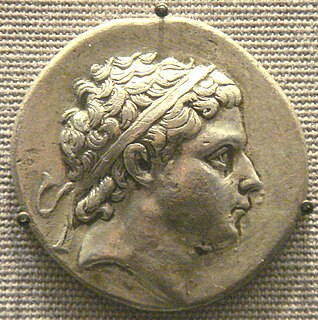
Prusias I Cholus was a king of Bithynia, the son of Ziaelas of Bithynia.

The Ramesseum is the memorial temple of Pharaoh Ramesses II. It is located in the Theban Necropolis in Upper Egypt, on the west of the River Nile, across from the modern city of Luxor. The name – or at least its French form Rhamesséion – was coined by Jean-François Champollion, who visited the ruins of the site in 1829 and first identified the hieroglyphs making up Ramesses's names and titles on the walls. It was originally called the House of millions of years of Usermaatra-setepenra that unites with Thebes-the-city in the domain of Amon.Usermaatra-setepenra was the prenomen of Ramesses II.

The Colossi of Memnon are two massive stone statues of the Pharaoh Amenhotep III, who reigned in Egypt during the Eighteenth Dynasty of Egypt. Since 1350 BCE, they have stood in the Theban Necropolis, located west of the River Nile from the modern city of Luxor.

The Scorpion King is a 2002 American action-adventure fantasy film directed by Chuck Russell, starring The Rock, Kelly Hu, Grant Heslov and Michael Clarke Duncan. It is a spin-off of The Mummy franchise and launched The Scorpion King film series. The film marks Johnson's first lead role.
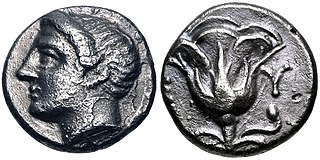
Memnon of Rhodes was a prominent Rhodian Greek commander in the service of the Persian Achaemenid Empire. Related to the Persian aristocracy by the marriage of his sister to the satrap Artabazus II, together with his brother Mentor he served the Persian king for most of his life, and played an important role during the invasion of Alexander the Great and the decades before that.

The Aethiopis, also spelled Aithiopis, is a lost epic of ancient Greek literature. It was one of the Epic Cycle, that is, the Trojan cycle, which told the entire history of the Trojan War in epic verse. The story of the Aethiopis comes chronologically immediately after that of the Homeric Iliad, and is followed by that of the Little Iliad. The Aethiopis was sometimes attributed by ancient writers to Arctinus of Miletus. The poem comprised five books of verse in dactylic hexameter.
Ariobarzanes was the second king of Pontus, succeeding his father Mithridates I Ctistes in 266 BC and died in an uncertain date between 258 and 240. He obtained possession of the city of Amastris in Paphlagonia, which was surrendered to him. Ariobarzanes and his father sought the assistance of the Gauls, who had come into Asia Minor twelve years before the death of Mithridates, to expel the Egyptians sent by Ptolemy II Philadelphus. Ariobarzanes was succeeded by Mithridates II.
Memnon of Heraclea was a Greek historical writer, probably a native of Heraclea Pontica. He described the history of that city in a large work, known only through the Excerpta of Photius, and describing especially the various tyrants who had at times ruled Heraclea.
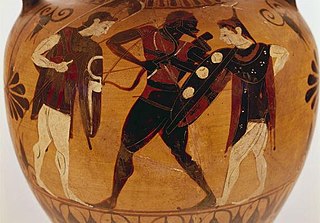
In Greek mythology, Memnon was an Ethiopian king and son of Tithonus and Eos. As a warrior he was considered to be almost Achilles' equal in skill. During the Trojan War, he brought an army to Troy's defense and killed Antilochus during a fierce battle. The death of Memnon echoes that of Hector, another defender of Troy whom Achilles also killed out of revenge for a fallen comrade, Patroclus.

The Younger Memnon is an Ancient Egyptian statue, one of two colossal granite heads from the Ramesseum mortuary temple in Thebes, Upper Egypt. It depicts the Nineteenth Dynasty Pharaoh Ramesses II wearing the Nemes head-dress with a cobra diadem on top. The damaged statue has since lost its body and lower legs. It is one of a pair that originally flanked the Ramesseum's doorway. The head of the other statue is still found at the temple.
2895 Memnon is a dark Jupiter trojan from the Trojan camp, approximately 56 kilometers in diameter. It was discovered on 10 January 1981, by American astronomer Norman Thomas at Lowell's Anderson Mesa Station near Flagstaff, Arizona, in the United States. The assumed C-type asteroid has a rotation period of 7.5 hours and belongs to the 80 largest Jupiter trojans. It was named after King Memnon from Greek mythology.
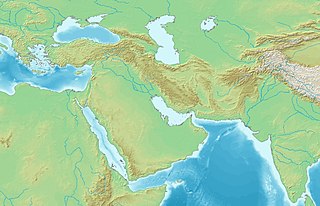
The Siege of Halicarnassus was fought between Alexander the Great and the Achaemenid Persian Empire in 334 BC. Alexander, who had no navy, was constantly being threatened by the Persian navy. It continuously attempted to provoke an engagement with Alexander, who would not oblige them. Eventually, the Persian fleet sailed to Halicarnassus, in order to establish a new defense. Ada of Caria, the former queen of Halicarnassus, had been driven from her throne by her younger brother Pixodarus of Caria. When Pixodarus died, Persian King Darius had appointed Orontobates satrap of Caria, which included Halicarnassus in its jurisdiction. On the arrival of Alexander in 334 BC, Ada, who was in possession of the fortress of Alinda, surrendered the fortress to him.
Pharnabazus III was a Persian satrap who fought against Alexander the Great. His father was Artabazus II, and his mother a Greek from Rhodes.
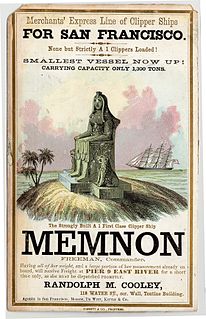
The Memnon was the first clipper ship to arrive in San Francisco after the Gold Rush, and the only clipper to arrive in San Francisco before 1850. Built in 1848, she made record passages to San Francisco and to China, and sailed in the first clipper race around Cape Horn.
Arctoseius latoanalis is a species of mite in the family Ascidae.

Saint Memnon the Wonderworker was alive during the second century A.D. He was a hegumen of an Egyptian monastery. His feast day is April 28.

Memnon was a British Thoroughbred racehorse and sire best known for winning the classic St Leger Stakes in 1825. In a racing career which lasted from 1824 until 1828 he ran fifteen times and won nine races. Bred and originally trained in Yorkshire, he was unbeaten in two races as two-year-old in 1824, including the Champagne Stakes and won the York version of the St Leger the following spring. In the St Leger at Doncaster in September 1825, he was successful as the heavily backed favourite in a record field of thirty runners. Memnon was later trained at Newmarket and recorded his most important subsequent victory when winning the Ascot Gold Cup as a five-year-old in 1827. After standing as a breeding stallion for five years in England with moderate results, he was sold and exported to Russia.













